Star Journey: The Intense Collaboration Behind 'Ain’t Burned All the Bright' by Jason Reynolds and Jason Griffin
“We’re like jazz musicians in that we decide on a structure, but a lot is left up to improvisation,” says Griffin about working with Reynolds. Read more about how this SLJ starred book came together.
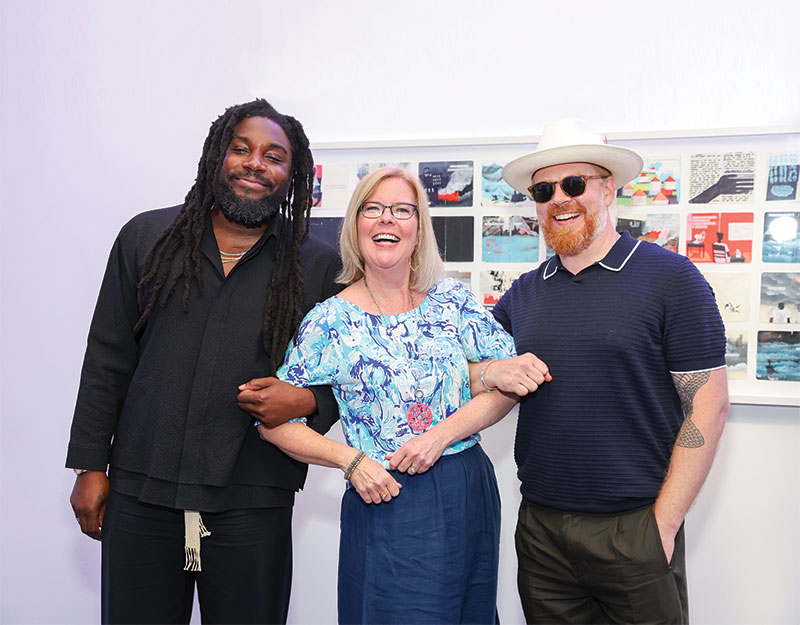 |
Jason Reynolds, Caitlyn Dlouhy, and Jason GriffinPhoto by Getty Images/Monica Schipper |
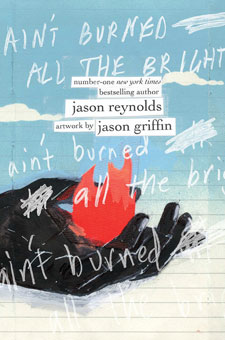 "Oxygen mask.” Artist Jason Griffin said those words to Jason Reynolds, his longtime friend and collaborator, during a phone call in the summer of 2020.
"Oxygen mask.” Artist Jason Griffin said those words to Jason Reynolds, his longtime friend and collaborator, during a phone call in the summer of 2020.
They were partnering on a project, and things weren’t clicking. Griffin mentioned how he was using Moleskine notebooks to sketch about various aspects of life during quarantine: the need to mask up before hitting the grocery store, the constant blaring of sirens, helping his sons with remote learning, the stream of bad news on TV, and the devastating forest fires in California. He described this project as an “oxygen mask” that was helping him break free and create when he felt blocked.
Still, the project felt stuck.
“At the time, I was trying to figure, how do you sum up 2020?” says Reynolds, the award-winning author and National Ambassador for Young People’s Literature. “I couldn’t find the language until he said those words, and then I realized, of course, this was a year of suffocation.”
He told Griffin he had an idea, but he wanted to take a day to think about it before sharing it with him.
After that call, Reynolds started writing what would become Ain’t Burned All the Bright, a stunning book that defies classification. It consists of three long sentences over the course of 300 pages that are full of evocative, dynamic artwork. It’s designed to look like a notebook, with collage elements and things scratched out. Some pages are left blank, and some are completely blacked out. It tells the story of a Black family living through the early days of the pandemic.
“Whether it be George Floyd and the way that he died, whether it be the tear gas in the street, whether it be [COVID-19’s] attack on the respiratory system, whether it be the L.A. wildfires—everything seemed to be cutting off our air,” says Reynolds. “Everything was sort of suffocating us, and when he said, ‘oxygen mask,’ it just helped me put it together.”
Reynolds says he took out a pen and a notebook and wrote the book in a matter of minutes, although the editing took much longer.
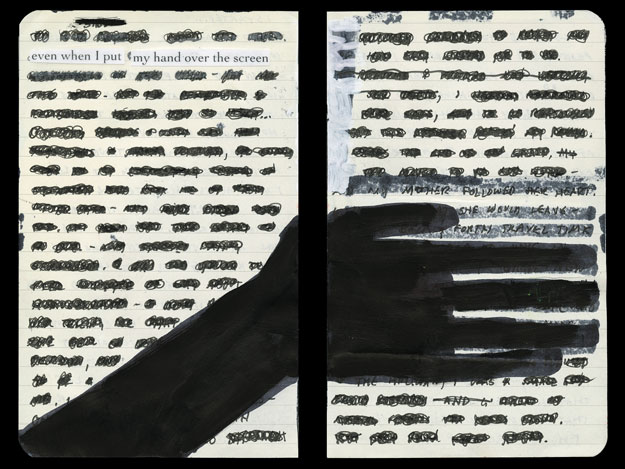
“I wrote it in one single run-on sentence,” he says. “It’s almost like there’s an enthusiasm—and when I say enthusiasm, I mean in the etymological sense. Historically, it means one is filled with God, entheos. There’s that feeling of, ‘I know something is happening. I know it is a visceral expulsion because whatever it is that’s in me finally decided that it’s ready.’”
Reynolds shared the first part of his work with Griffin the next day. The book is divided into three sections: Breath One, Breath Two, and Breath Three. Throughout their collaboration, Reynolds would share one section at a time with Griffin, who would then begin working on the art to accompany it.
“Immediately, I stripped all the punctuation from the breath before I gave them to him because I wanted him to be free to move the language around, however he saw fit, which is why everyone thinks it’s this poem,” says Reynolds. “But really, it’s a bunch of semicolons and commas in it that I took out because I didn’t want him to be hung up on them. I wanted him to be free to do his thing.”
Griffin ran with that, using some images he had already sketched in his notebooks and creating new ones to complement the text. He completed the first 10 spreads in a month of working at home. After that, he acquired some studio space to free himself from distractions, which allowed him to put the spreads on the wall so he could easily see the transitions and how the book flowed.
For him, this wasn’t about illustrating Reynolds’s words.
“We’re like jazz musicians in that we decide on a structure, but a lot is left up to improvisation,” says Griffin. “There’s call and response. We both have our own instruments. Neither is illustrating the other. His writing, it’s not about my art; and my art, it’s not about his writing. We’re taking a central theme, and we’re riffing. We’re jamming out.”
This style of joining words and images also leaves many things open to the reader’s interpretation.
“We’re not making it so on the nose that you have to think about something specific,” says Griffin. “The pairing of the two in this way hopefully allows for many iterations and personal connections.”
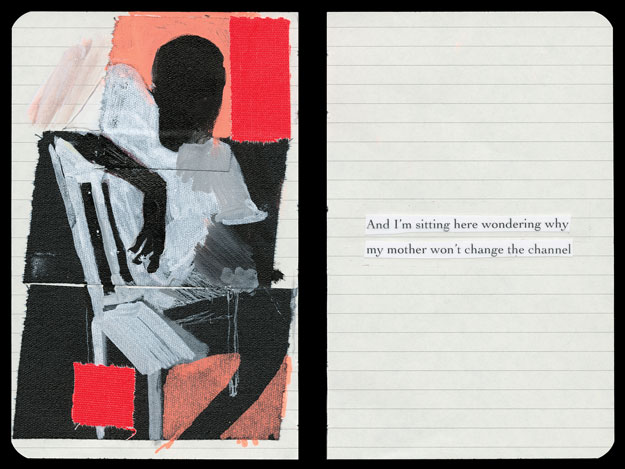
An editor “tackles the genius”
Their collaborative work on this project went on for several months, and by early 2021, Griffin and Reynolds were ready to hand off their manuscript to Caitlyn Dlouhy, editorial director at Caitlyn Dlouhy Books, a division of Simon and Schuster.
“I finished reading it and kind of slumped back in my chair and thought, ‘This is genius,’” says Dlouhy. “That was truly my very first thought, and then I didn’t know what the heck to do, because I had genius in my hands.”
So, she says, she let it sit for a bit and then started to “tackle the genius.”
Dlouhy describes her work as bringing “small finesses” to the text through suggestions about things, such as pacing.
“There might be a phrase that Jason uses that is so spot-on, but I have a feeling the kid in the back of the classroom is not quite going to get it if they’re reading too quickly,” says Dlouhy. “How do we make pauses visually on the page so that you help a younger reader who doesn’t have quite the sophistication in what they’ve read before as an adult would to pause and really take in some information before they flip to the next page. Because when something’s short, you tend to go faster and faster and faster. But when you go faster and faster and faster, you sometimes don’t leave yourself the room to take in what’s actually been said.”
Dlouhy also came up with the book’s title. Initially, it was going to be Oxygen Mask and then Three Breaths. But neither of those was just right. So Dlouhy started flipping through the manuscript, looking for anything that generated a spark. She came across a line about the narrator looking in on his dad, who’s sick and isolated in a bedroom.
“...so I keep peeking through a crack in the door, and when he sees me he smiles because the fever ain’t burned all his bright up yet…”
“I started playing with the idea of bright, bright, bright, and that led to Ain’t Burned All the Bright,” says Dlouhy. “The Jasons and I just went back and forth on a number of titles, and we kept circling back to that one.”
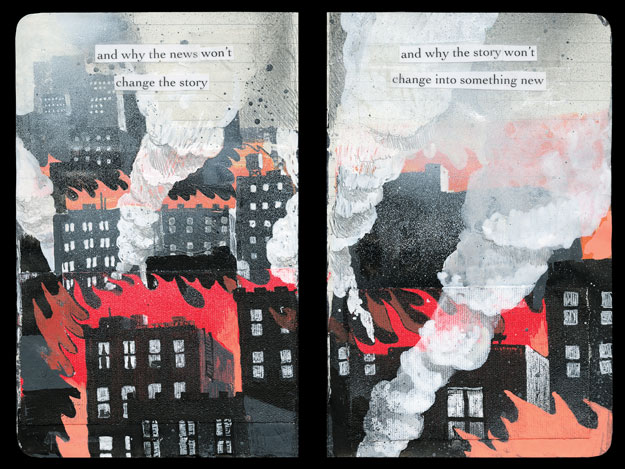
A package that’s “a little rough”
When the Jasons sent the manuscript to Dlouhy, it was in the form of a massive PDF. Simon and Schuster art director Michael McCartney recalls 350 to 400 pages of full-color art that was completely finished, with the text already laid out. The publishing team only had three months to go from that PDF to a finished book. Normally, this process would take a year.
It took a lot of back-and-forth between McCartney and the Jasons to get the jacket just right. Eventually, they decided on an image of a hand holding a vibrant, orange flame, which was adapted from the interior of the book.
The jacket also features the title of the book several times after McCartney asked Griffin to hand-letter it. He started writing the title over and over with the plan to take the best one and use it, but then they decided to stick with what he was doing.
“It’s a little scribbly,” says McCartney. “There’s some parts he crossed out. We left those in there. It just felt like this package should show the handcrafted quality that Jason Griffin put into everything.”
The jacket was also designed to look like there’s tape covering the names of Reynolds and Griffin, which were typed in lowercase letters.
“We just started to embrace that as the notion of this package being a little rough, and not so commercial,” says McCartney. “We had the liberty to do that because Jason Reynolds is so big right now that most anything that we put out there, everyone’s really eager to gobble up.
“We had some freedom, and we ran with it.”
Marva Hinton is a freelance journalist, a contributing editor at Edutopia, and the host of the “ReadMore” podcast.
RELATED
The job outlook in 2030: Librarians will be in demand
The job outlook in 2030: Librarians will be in demand
ALREADY A SUBSCRIBER? LOG IN
We are currently offering this content for free. Sign up now to activate your personal profile, where you can save articles for future viewing






Add Comment :-
Be the first reader to comment.
Comment Policy:
Comment should not be empty !!!